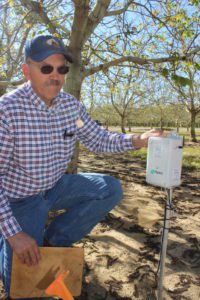Don’t Play A Guessing Game
Farm advisors and professionals in orchard water management emphasize that tools to determine soil moisture in relation to water holding capacity of the soils and tree water stress in your walnut orchards are critical to irrigation decisions.
Allan Fulton, University of California Cooperative Extension (UCCE) irrigation and water resources advisor in Tehama County, said, many walnut growers and managers in the Central Valley are using some combination of soil moisture sensors, water budgeting, and tree stress indicators to determine initial irrigation needs and they also use them to make sure trees have adequate moisture throughout the growing season.
Proper use of those tools can prevent over or under irrigation, and stress on trees, ultimately improving production, consistency and potential.
Why would a grower risk guessing on such a critical piece (plant available water) in the complex environment that makes up their soil profile, asked Brian Bassett of H2O Optimizer.
Bassett said his company’s clients ended the year by recharging the soil profile to about 70 percent of field capacity, in the event that winter rains arrive. Leaching doesn’t take place in a dry soil, he noted, so having some level of moisture allows rainfall to create the leaching as opposed to filling the soil profile.

Growing degree-days are compared to historical bud break or bloom to determine bloom or bud break for the current year. Initial irrigations are to refill soil profiles determined by the sensors. Depending on growing region, soil profile and weather conditions, Bassett said winter irrigations in walnut begin the second week of February.
Soil profile is important, he noted because clays are slow to fill. Irrigations on sandy soils are closer to bloom or bud break to avoid water leaching.
Correct timing and length of irrigations is important because depletion or excess soil moisture in orchards can lower plant vigor or create an environment for the spread of fungal diseases. Nutrient uptake can also be affected.
This Winter
In mid February, Fulton said with the continued dry conditions, he expected to see more winter irrigation in north valley walnut orchards. In a normal rainfall year, winter irrigation is not necessary in the north valley. It is more common in the south valley, for growers to do one or two winter irrigations to keep the soil moisture levels adequate. Average precipitation can exceed 20 inches in northern walnut growing regions and be as low as four inches in southern regions of the Central Valley.
With continued dry weather and recent cold streak a week later, Fulton said more north valley walnut growers are irrigating this winter in both young and mature orchards. Water applications in young orchards may be motivated to reduce risk of winter kill of shoots that were grown last season as well to refill the soil profile.

“What is different this dry year, chances are without winter irrigation, you will start out with a drier soil profile and need to irrigate earlier in the season,” Fulton said. One or two winter irrigations delivering about 2 to 4 inches of water will help refill the soil profile and allow more delay of the first crop irrigation in the spring, he added. By delaying the start of crop irrigations, he said growers can help protect their trees from low oxygen levels when the trees leaf out and are growing new roots. Also, it helps lessen root diseases that thrive in saturated soils and should provide better access into orchards for pest management unless it rains substantially in April.
Factors In Irrigation Management This Coming Season
Fulton said there can be a tendency to over irrigate in the spring and under irrigate in the summer. It’s important to root and tree health not to begin irrigation too early, irrigate too frequently, or too long of a duration in the spring as the trees begin to grow. One northern Sacramento Valley irrigation experiment in Chandler walnut has shown after four years of evaluation that there is a good chance that irrigation may not be necessary during the month of April and that the start of the irrigation season may be delayed until sometime in May. When to begin irrigation in May will be orchard specific and dependent upon the water holding capacity of the orchard soils and how the absence of rain and winter irrigation was managed.
Research in the late 1980’s at the Kearney Agricultural Research and Extension Center and more recent research from 2011-16 in the northern Sacramento Valley indicate a reasonable estimate for seasonal evapotranspiration (ET) is 40 to 42 inches for mature walnut orchards. This should represent a reasonable upper limit for total seasonal water needs for mature walnut. About one fourth of the seasonal ET will occur from leaf out (about April 1st) through hull and shell enlargement (mid-June). The remaining three quarters of the seasonal water use occurs mid-June through mid-November as the kernel inside the shell develops, matures, and is harvested. Soil moisture reserves from winter rainfall or winter irrigation can contribute significantly towards this total seasonal ET and lessen irrigation needs during the growing season. Most orchard soils can contribute at least four inches (10 percent) and as much as 12 inches (30 percent) of stored water towards seasonal ET if they have been replenished from winter rainfall or winter irrigation.
Age of the orchard does make a difference. Young trees with smaller, developing canopies have lower seasonal water requirements. Young trees in their second and third leaf with an established root system may take a longer delay in the start of irrigation than a mature orchard. Also, interval between irrigations may be longer in young, developing trees. The exception is the first year, especially early in the season. Potted trees or bare root trees where small root systems are being transplanted into new soils, Fulton explained, may need earlier, light and frequent irrigations until the transplanted tree is able to grow new roots and establish a root system. Once the newly planted tree becomes established light, frequent irrigations may not be necessary, if the tree can acquire stored water from a larger, deeper soil profile. Pruning strategies that affect canopy development can also affect water use, he noted.
Irrigation systems that apply water uniformly and in controlled quantities will also lessen irrigation needs during the irrigation season. Flooding the entire soil surface should be avoided in very young orchards. With flood irrigation, a lot of water will be applied in areas where the young trees have not yet developed a root system to use the water. This often results in more weed competition and low irrigation efficiencies. Furrow irrigation about 18 inches from the tree row can be used for the first year on some soils where water infiltrates uniformly and moves laterally. This can also reduce weed pressure and loss of water when compared to flood irrigation. However, furrow irrigation can still be risky on highly variable orchard soils, especially when planting potted or bare root trees with small root balls. Drip and micro sprinkler irrigation with drip emitters or a capped sprinkler located near the transplanted trees will be more efficient.
Fulton encourages growers to have their own set of diagnostic tools to evaluate on site conditions and optimize irrigation management throughout the growing season. The general options are to monitor soil moisture, tree water stress, and budget their water using flow meter measurements, ET estimates, and irrigation system performance information. Often there is value in employing more than one of these approaches.

Cecilia Parsons
Cecilia Parsons has lived in the Central Valley community of Ducor since 1976, covering agriculture for numerous agricultural publications over the years. She has found and nurtured many wonderful and helpful contacts in the ag community, including the UCCE advisors, allowing for news coverage that focuses on the basics of food production.
She is always on the search for new ag topics that can help growers and processors in the San Joaquin Valley improve their bottom line.
In her free time, Cecilia rides her horse, Holly in ranch versatility shows and raises registered Shetland sheep which she exhibits at county and state fairs during the summer.
















